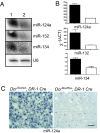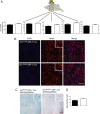Dicer loss in striatal neurons produces behavioral and neuroanatomical phenotypes in the absence of neurodegeneration
- PMID: 18385371
- PMCID: PMC2291142
- DOI: 10.1073/pnas.0801689105
Dicer loss in striatal neurons produces behavioral and neuroanatomical phenotypes in the absence of neurodegeneration
Abstract
MicroRNAs (miRNAs) are small noncoding RNAs that can act to repress target mRNAs by suppressing translation and/or reducing mRNA stability. Although it is clear that miRNAs and Dicer, an RNase III enzyme that is central to the production of mature miRNAs, have a role in the early development of neurons, their roles in the postmitotic neuron in vivo are largely unknown. To determine the roles of Dicer in neurons, we ablated Dicer in dopaminoceptive neurons. Mice that have lost Dicer in these cells display a range of phenotypes including ataxia, front and hind limb clasping, reduced brain size, and smaller neurons. Surprisingly, dopaminoceptive neurons without Dicer survive over the life of the animal. The lack of profound cell death contrasts with other mouse models in which Dicer has been ablated. These studies highlight the complicated nature of Dicer ablation in the brain and provide a useful mouse model for studying dopaminoceptive neuron function.
Conflict of interest statement
The authors declare no conflict of interest.
Figures





Similar articles
-
Age-dependent neuron loss is associated with impaired adult neurogenesis in forebrain neuron-specific Dicer conditional knockout mice.Int J Biochem Cell Biol. 2014 Dec;57:186-96. doi: 10.1016/j.biocel.2014.10.029. Epub 2014 Nov 3. Int J Biochem Cell Biol. 2014. PMID: 25448413
-
Dicer ablation in oligodendrocytes provokes neuronal impairment in mice.Ann Neurol. 2009 Dec;66(6):843-57. doi: 10.1002/ana.21927. Ann Neurol. 2009. PMID: 20035504 Free PMC article.
-
Wnt1-cre-mediated conditional loss of Dicer results in malformation of the midbrain and cerebellum and failure of neural crest and dopaminergic differentiation in mice.J Mol Cell Biol. 2010 Jun;2(3):152-63. doi: 10.1093/jmcb/mjq008. Epub 2010 May 10. J Mol Cell Biol. 2010. PMID: 20457670
-
Dicer is required for the transition from early to late progenitor state in the developing mouse retina.J Neurosci. 2010 Mar 17;30(11):4048-61. doi: 10.1523/JNEUROSCI.4982-09.2010. J Neurosci. 2010. PMID: 20237275 Free PMC article.
-
Dicer cuts the kidney.J Am Soc Nephrol. 2008 Nov;19(11):2043-6. doi: 10.1681/ASN.2008090986. Epub 2008 Oct 15. J Am Soc Nephrol. 2008. PMID: 18923053 Review. No abstract available.
Cited by
-
Let-7b/c enhance the stability of a tissue-specific mRNA during mammalian organogenesis as part of a feedback loop involving KSRP.PLoS Genet. 2012;8(7):e1002823. doi: 10.1371/journal.pgen.1002823. Epub 2012 Jul 26. PLoS Genet. 2012. PMID: 22844247 Free PMC article.
-
MicroRNA: Implications for Alzheimer Disease and other Human CNS Disorders.Curr Genomics. 2009 May;10(3):154-68. doi: 10.2174/138920209788185252. Curr Genomics. 2009. PMID: 19881909 Free PMC article.
-
A β-synuclein mutation linked to dementia produces neurodegeneration when expressed in mouse brain.Nat Commun. 2010 Nov 2;1:110. doi: 10.1038/ncomms1101. Nat Commun. 2010. PMID: 21045828 Free PMC article.
-
Residual microRNA expression dictates the extent of inner ear development in conditional Dicer knockout mice.Dev Biol. 2009 Apr 15;328(2):328-41. doi: 10.1016/j.ydbio.2009.01.037. Epub 2009 Feb 4. Dev Biol. 2009. PMID: 19389351 Free PMC article.
-
Dicer expression is essential for adult midbrain dopaminergic neuron maintenance and survival.Mol Cell Neurosci. 2014 Jan;58:22-8. doi: 10.1016/j.mcn.2013.10.009. Epub 2013 Oct 31. Mol Cell Neurosci. 2014. PMID: 24184162 Free PMC article.
References
-
- Valencia-Sanchez MA, Liu J, Hannon GJ, Parker R. Control of translation and mRNA degradation by miRNAs and siRNAs. Genes Dev. 2006;20:515–524. - PubMed
-
- Kosik KS. The neuronal microRNA system. Nat Rev. 2006;7:911–920. - PubMed
-
- Bernstein E, et al. Dicer is essential for mouse development. Nat Genet. 2003;35:215–217. - PubMed
Publication types
MeSH terms
Substances
Grants and funding
LinkOut - more resources
Full Text Sources
Molecular Biology Databases

